Germany
View:
November 21, 2025

U.S. Asset Inflows After April’s Trump Tariffs
November 21, 2025 8:00 AM UTC
· Net foreign portfolio inflows have not been hurt by Trump’s April tariff drama, with the AI and tech boom attracting new equity inflows. Flows could become more volatile with a U.S. equity bear market or recession, but these are modest risk alternative scenarios rather than high r
November 18, 2025

Markets 2026
November 18, 2025 10:30 AM UTC
· The Fed, ECB and BOE will likely drive further 10-2yr government bond yield curve steepening, with 10yr Bund yields rising due to ECB QT and German fiscal expansion. 10yr JGB yields are set to surge through 2%, as BOJ QT remains excessive and underestimated. The BOJ could partiall
November 17, 2025

Financial Stability Risks: Vulnerable To A Recession
November 17, 2025 1:00 PM UTC
The November Fed financial stability review highlights continued concern over hedge funds and insurance company leverage, while the IMF GSFR is concerned about U.S. equity market overvaluation and growing links between banks and non-bank financial intermediaries. However, the main adverse shock wo
November 14, 2025

ECB – In a Good Place or Just Complacent?
November 14, 2025 11:55 AM UTC
The ECB is of the view that downside growth risks have dissipated somewhat, this possibly helped by its recent actions which it suggests leave its current policy stance in a good place. However, amid a hint of what we think is a complacent upgrade about the EZ’s alleged resilience, we think, the
November 11, 2025

EZ Rates: 2026 ECB Easing But 2027 French Crisis?
November 11, 2025 9:45 AM UTC
· Financial conditions are tighter than suggested by a 2% ECB depo rate, which will both dampen an EZ economic pick-up and cause further disinflation. We see the ECB delivering two further 25bps cuts to a 1.5% ECB depo rate, which can mean a further decline in 2yr Bund yields. Howev
October 31, 2025
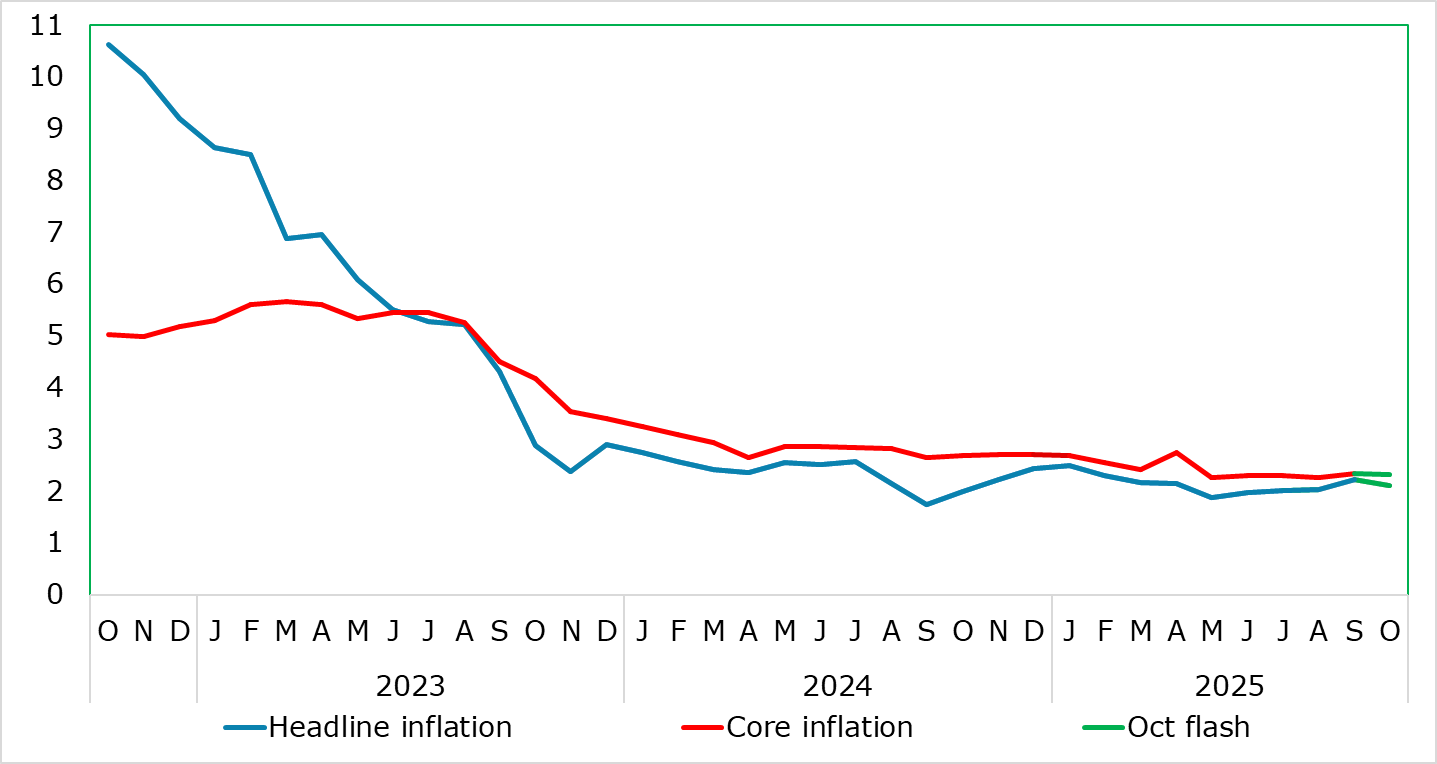
EZ HICP Review: Services Inflation Problematic?
October 31, 2025 10:39 AM UTC
With what were previously unfavourable energy-related base effects reversing, EZ inflation edged down 0.1 ppt to 2.1% in October, largely in line with consensus thinking, but with the main core rate stable at 2.4%. The latter reflected a slight pick-up in services (up 0.2 ppt to a six-mth high of
October 30, 2025
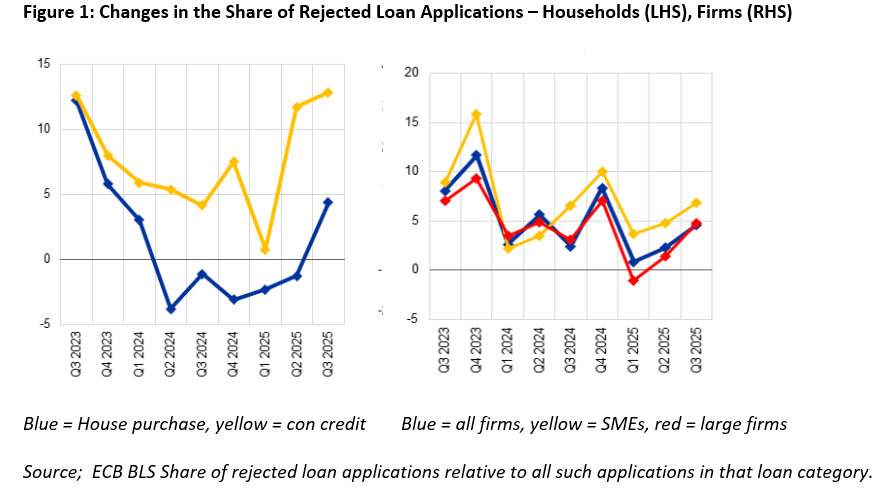
ECB Review: Hedging its Bets, Hoping to Stay in a Good Place
October 30, 2025 3:23 PM UTC
There ie nothing tangible in the ECB update today to suggest that a further easing is likely at the next meeting on Dec 17-18. However, amid a hint of what we think is a complacent upgrade about the EZ’s resilience alongside a perceived reduction in global risks, the easing window has not been c

Eurozone Flash GDP Review: The Haves and the Have-Nots
October 30, 2025 10:25 AM UTC
It continues to be the case that, for an economy that has seen repeated upside surprises and apparently above trend growth, now some 1.3% in the year to Q3, GDP data do not seem to have had much impact is shaping, let alone dominating, ECB policy thinking save to encourage a Council view of EZ eco
October 28, 2025
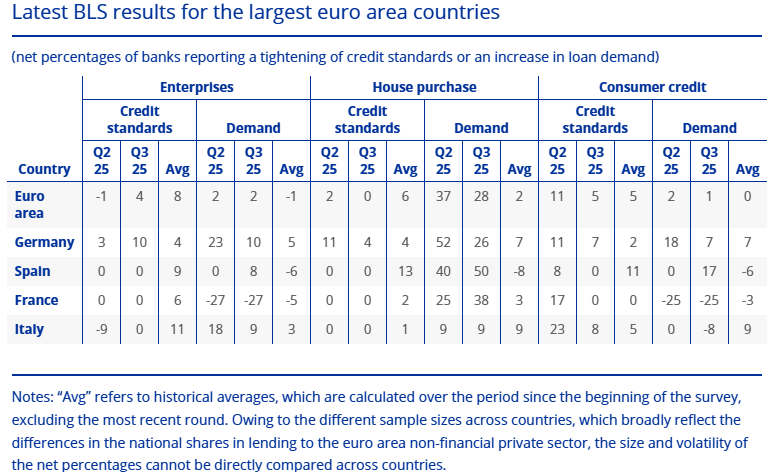
Eurozone: Tighter Credit Standards By EZ Banks Confirmed
October 28, 2025 9:44 AM UTC
Hardly a surprise despite the ECB suggestions to the contrary as the reported net tightening credit standards merely accentuates trends in the two previous Bank Lending Surveys (BLS). This updated BLS therefore echoes what we have seen in other ECB surveys and in actual credit dynamics and thus un
October 27, 2025
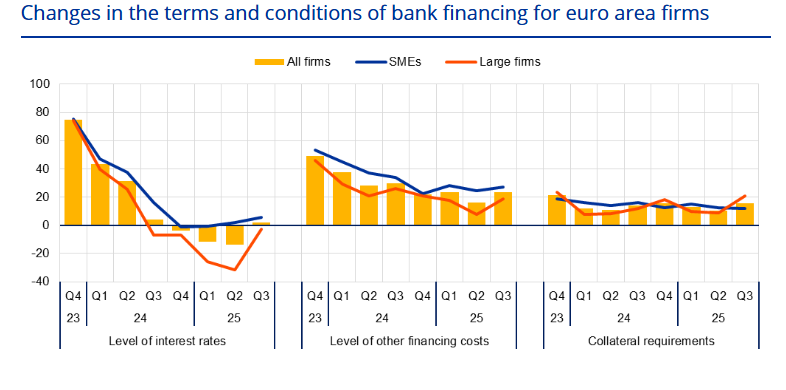
ECB Monetary Worries Emerging as Corporate Credit Dynamics Weaken More Clearly
October 27, 2025 10:36 AM UTC
As a foretaste of the Bank Lending Survey BLS) due tomorrow, the ECB released two associated pieces of data today, both corroborating and continuing an ever worrying pattern, namely weakness in corporate credit. The data showed growth in later has fallen to its lowest in almost two years (Figure 1).
October 23, 2025
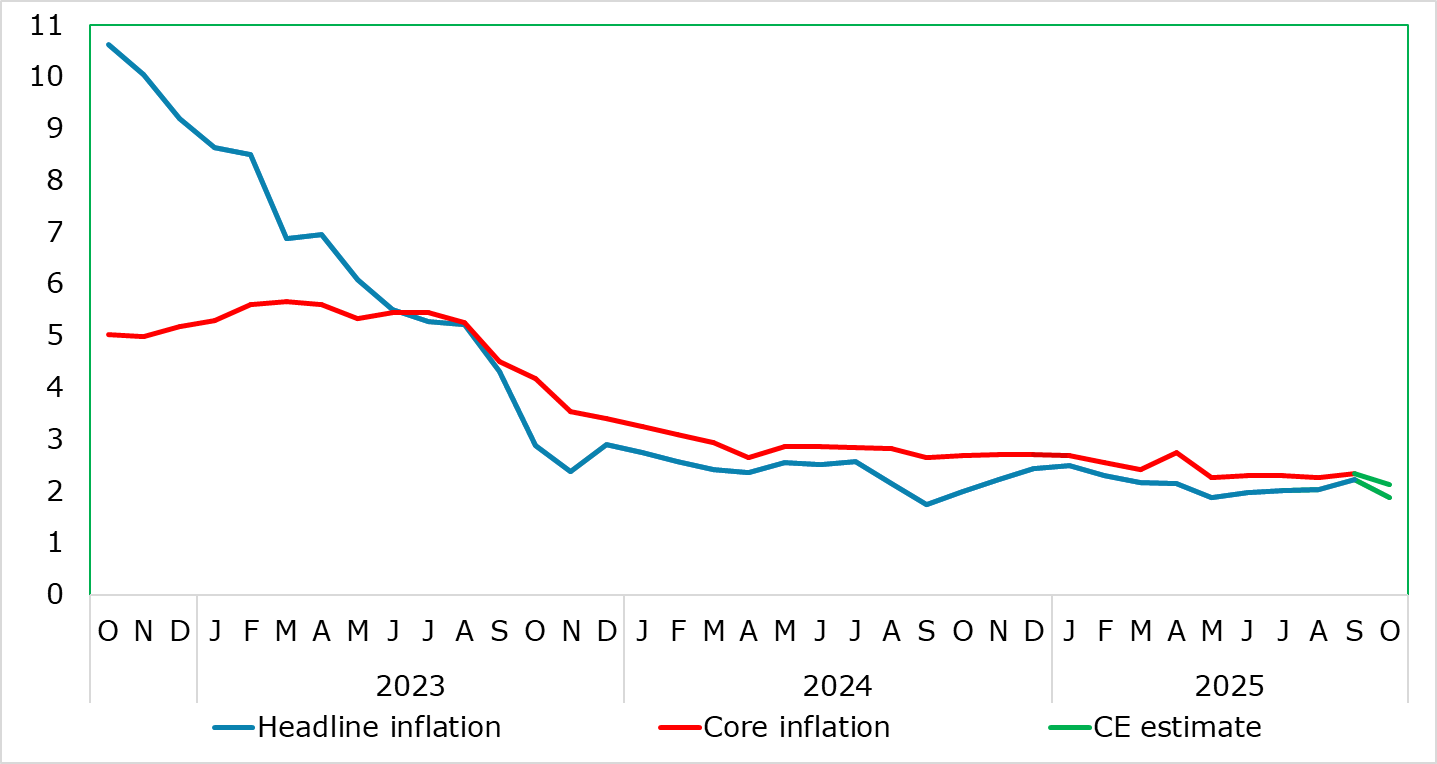
EZ HICP Preview (Oct 31): No Halloween Horror from HICP Update
October 23, 2025 12:09 PM UTC
Mainly due to unfavourable base effects, EZ inflation has edged up in the last few months, but we think that this is temporary and that a fresh fall, possible to below the 2% target may occur in the October flash numbers – with a formal forecast of a 0.3 ppt drop to 1.9% and the core falling almos
October 22, 2025
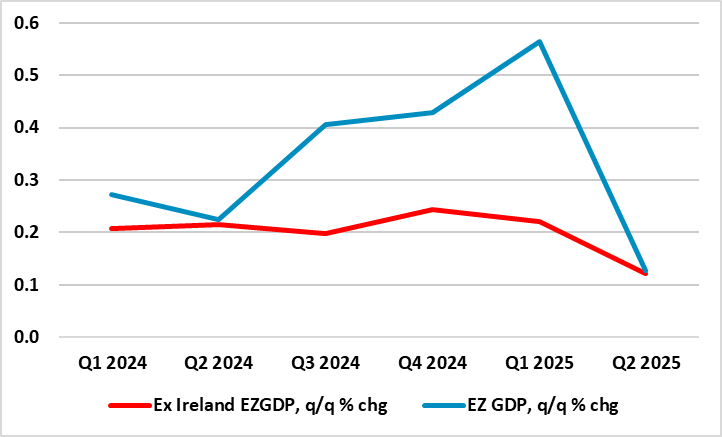
Eurozone Flash GDP Preview (Oct 30): Resilience in the Dock?
October 22, 2025 9:11 AM UTC
As we highlighted repeatedly of late, for an economy that has seen repeated upside surprises and apparently above trend growth, now some 1.4% in the year to Q2, GDP data do not seem to have had much impact is shaping, let alone dominating, ECB policy thinking. But we think this may shift as the ECB
October 21, 2025
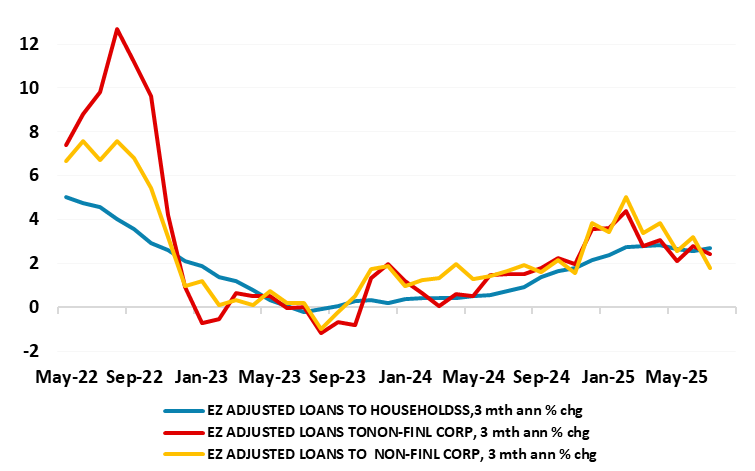
ECB Preview (Oct 30): Assessing the ‘Punchbowl’
October 21, 2025 12:55 PM UTC
As with recent Council meetings, what is important when the ECB gives its next (almost certain) stable verdict on Oct 30, is not what it says. Instead, in particular, it is how much the impression is left that the easing window has not closed. The ECB is clearly split about whether policy has trou
October 20, 2025
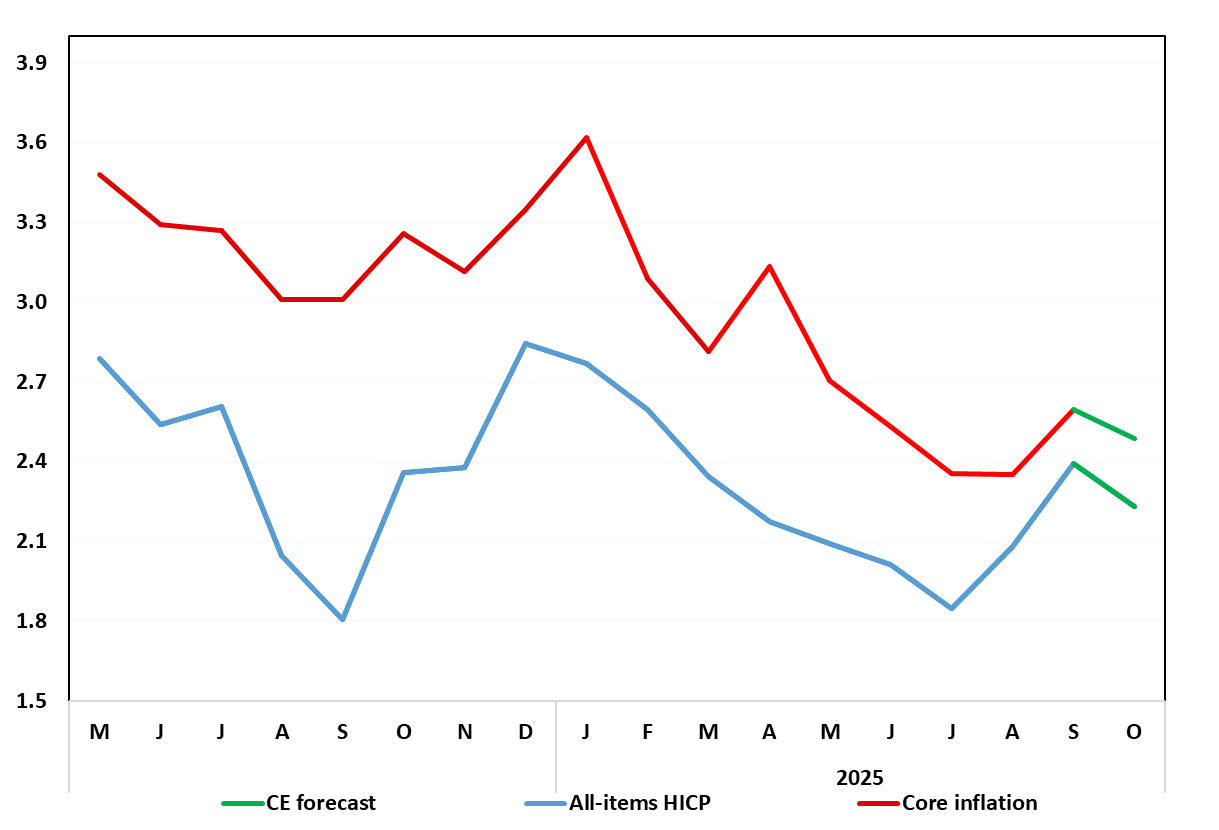
German HICP Preview (Oct 30): Headline Core To Edge Down as Disinflation Resumes?
October 20, 2025 4:36 PM UTC
Germany’s disinflation process hit a further and more-than-expected hurdle in September, as the HICP measure rose 0.3 ppt for a second successive month, thereby even more clearly up from July’s 1.8% y/y, that having been a 10-mth low. But we see most, if not all, of this rise being reversed in
October 17, 2025
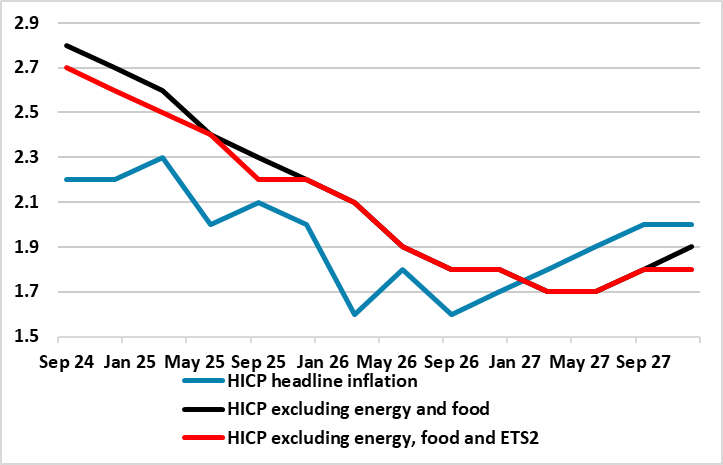
EZ Inflation Outlook: The Deeper Debate About 2028?
October 17, 2025 10:24 AM UTC
The ECB is clearly split about whether policy has troughed or not, this mainly a result of differences within the Council as to where inflation risks lie. Hawks perceive upside risks emerging while the dovish camp feels the opposite. These divisions are likely to magnify when the ECB updates its
October 10, 2025
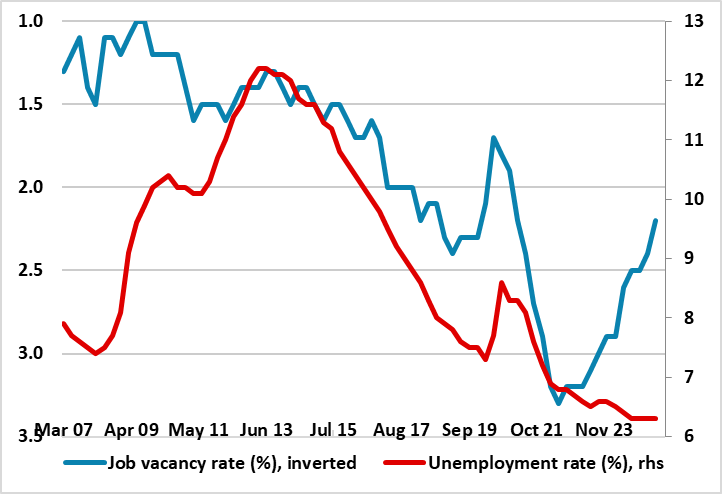
Eurozone: Data Disappointments Off the ECB Radar
October 10, 2025 12:35 PM UTC
Although not fully high-profile,and mostly off the radar that the Council focuses on. the last few days have brought a series of data releases that will disappoint the ECB, certainly the hawks. These range from weak services production data, further signs of a loosening in the labor market and mor
October 09, 2025
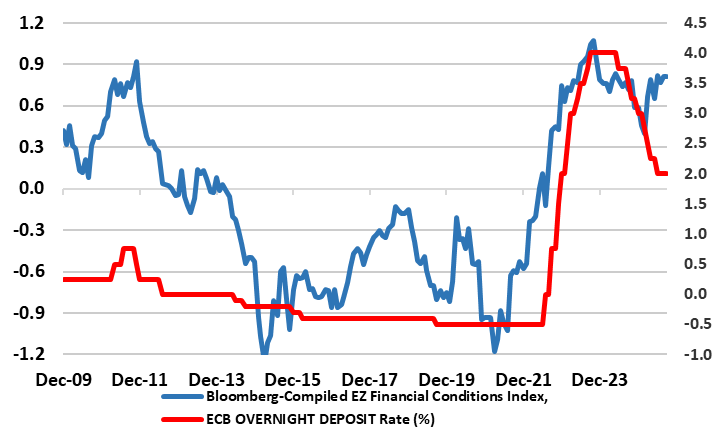
ECB Council Meeting Account Review: Complacency Rules the Day as Financial Conditions Tighten!
October 9, 2025 12:52 PM UTC
Unsurprisingly there was little in the account of the ECB Council Meeting of 10-11 September to suggest any rush to change policy with it clear that members on both sides of the hawks vs doves debate wanted more data amid what was considered to be great uncertainty. Thus, the ECB offered little in
October 02, 2025

DM Central Banks: Wider-Ranging Conditions More Than Neutral Rates
October 2, 2025 6:55 AM UTC
· Neutral policy rate estimates and forward guidance provide some help at the start of easing cycles, but less so at mid to mature stages. For the Fed, ECB and BOE we look at a wider array of economic and financial conditions, alongside our own projections over the next 2 years to m
October 01, 2025
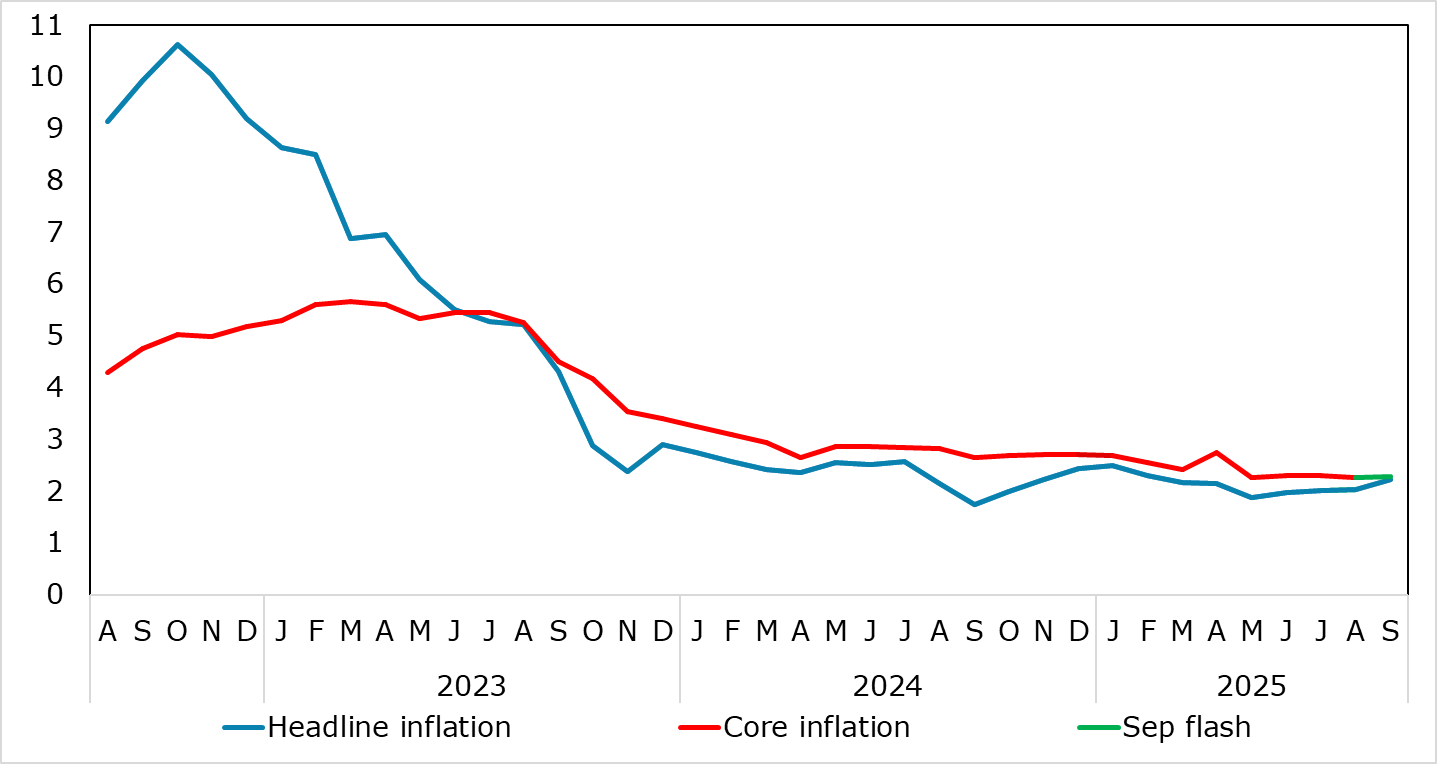
EZ HICP Review: Headline Inflation Moves Higher as Services Ticks Up From Cycle-low
October 1, 2025 10:28 AM UTC
A second successive upside surprise is unlikely to make inflation any more of an issue for the ECB at present. Instead, moderate concerns whether the apparent resilience of the real economy may yet falter should remain the order of the day, this possibly a result of a still somewhat unresponsive t

AI/Humanoid Robots and Disinflation?
October 1, 2025 9:40 AM UTC
· Overall, a number of forces from the AI wave will impact inflation. Power demand could push up power prices, but productivity enhancements and product innovation could be disinflationary like Information and Communications technology (ICT). One other key uncertainty on a 1-5 year
September 30, 2025
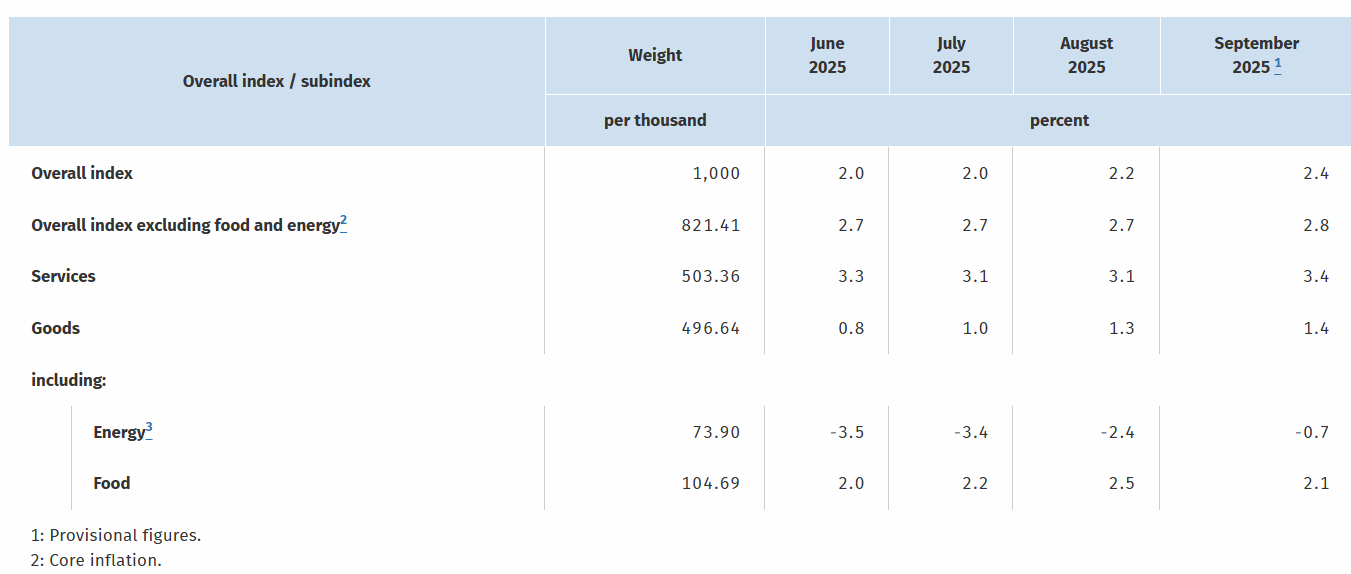
German HICP Review: Headline Higher And Core Rises Due to Fresh Services Push?
September 30, 2025 12:25 PM UTC
Germany’s disinflation process hit a further more-than-expected hurdle in September, as the HICP measure rose 0.3 ppt for a second successive month, thereby even more clearly up from July’s 1.8% y/y, that having been a 10-mth low (Figure 1). This (again) occurred largely due to energy base eff
September 29, 2025

DM Government Bond Saints v U.S.
September 29, 2025 7:35 AM UTC
· Overall, although the fiscal saints (Australia/Canada/Germany/Sweden) have merits over the U.S. in the scenario where Fed independence is undermined and more Fed rate cuts occur than warranted by the economics, the 10yr area of other government bond markets may not outperform. 10yr go
September 26, 2025
September 25, 2025
September 24, 2025

EZ HICP Preview (Oct 1): Headline Inflation to Edges Higher as Services Slows to Fresh Cycle-low
September 24, 2025 10:54 AM UTC
As we have underlined of late, HICP inflation – at target for the last three months – is very much a side issue for the ECB at present, offset instead by moderate concerns whether the apparent resilience of the real economy may yet falter. This mindset will not be altered by the flash HICP dat
September 23, 2025

DM FX Outlook: USD steadies but vulnerable to equity correction
September 23, 2025 2:48 PM UTC
· Bottom Line: The USD has continued to edge lower against the EUR in the last quarter as market expectations of Fed easing have increased following clear weakening in U.S. employment growth. But at this stage the data doesn’t indicate we are heading for recession, and this suggests w
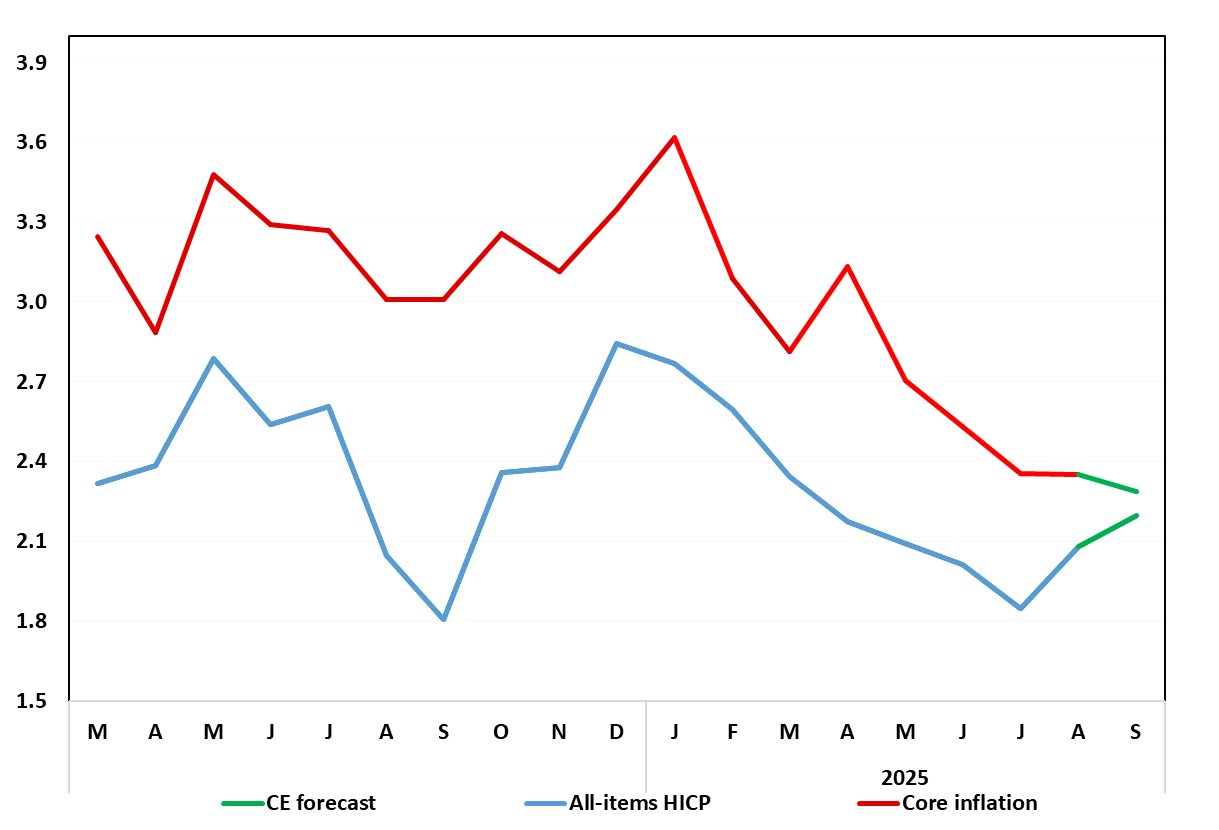
German HICP Preview (Sep 30): Headline Higher But Core to Fall Further?
September 23, 2025 2:21 PM UTC
Germany’s disinflation process hit a slightly more-than-expected hurdle in August, as the HICP measure rose 0.3 ppt from July’s 1.8% y/y, that having been a 10-mth low (Figure 1). This occurred largely due to energy base effects with food prices also contributing slightly. The result was that

Outlook Overview: Into 2026
September 23, 2025 8:25 AM UTC
· The critical question is how much the U.S. economy is slowing down with the feedthrough of President Donald Trump’s tariffs to boost inflation and restrain GDP growth, with the effective rate currently around 17% on U.S. imports. Though semiconductor tariffs are likely, the bulk of

DM Rates Outlook: Steepening Yield Curve The Old Normal?
September 23, 2025 7:53 AM UTC
• We continue to forecast further yield curve steepening across the U.S./EZ and UK, driven by cumulative easing. For the U.S. this can see a modest further decline in 2yr yields, but the prospect is for a move to a premium of 2yr to Fed Funds (unless a hard landing is seen). 10yr yields

Equities Outlook: Correction Then Up In 2026
September 23, 2025 7:15 AM UTC
• The U.S. equity market’s bullishness reflects good corporate earnings reality, buybacks and the AI story. However, we feel that the U.S. economy can deteriorate still further in the coming months, as the lagged effects of tariffs boost inflation and restrain spending/hurt corporate ea
September 22, 2025

Eurozone Outlook: Resilience or Irrelevance?
September 22, 2025 9:49 AM UTC
·· Yet again, and amid what may still be tightening financial conditions and likely protracted trade uncertainty, we have pared back the EZ activity forecast for 2026. However, the picture this year appears to be slightly better but this is largely a distortion and we think that the ec
September 11, 2025

ECB Council Meeting Review: Complacency Rules the Day!
September 11, 2025 2:08 PM UTC
A second successive stable policy decision was the almost inevitable outcome of this month’s ECB Council meeting resulting in the first consecutive pause in the current easing cycle, with the discount rate left at 2.0%. Also as expected, the ECB offered little in terms of policy guidance; after
September 10, 2025

DM Rates: Steeper Yield Curves: More to Come?
September 10, 2025 10:55 AM UTC
Steeper yield curves are a function of monetary easing cycles, budget deficits, lower central bank holdings of government bonds, a move towards pre GFC real rates and shifting demand from pensions funds and life insurance companies. Scope exists for further steepening in the U.S., EZ and UK with m
September 03, 2025
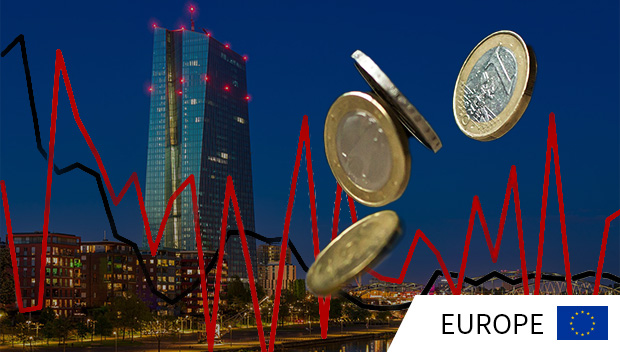
ECB Council Meeting Preview (Sep 11): No Change and Little Guidance
September 3, 2025 9:20 AM UTC
A second successive stable policy decision is very likely at next week’s ECB Council meeting resulting in the first consecutive pause in the current easing cycle, with the discount rate left at 2.0%. We see the ECB offering little in terms of policy guidance; after all, in July the Council sugge
September 02, 2025

EZ HICP Review: Headline Inflation Edges Higher as Services Fall to Fresh Cycle-low
September 2, 2025 9:34 AM UTC
As we repeated again, HICP inflation – even now a notch above target – is very much a side issue for the ECB at present, offset instead by moderate concerns whether the apparent resilience of the real economy may yet falter. This mindset will not have been altered by the flash HICP data for Au
September 01, 2025

Aging: Slow Growth for Some in 2020’s
September 1, 2025 8:35 AM UTC
Population aging always seems to be beyond the market horizon, but the 2020’s are already seeing population aging in some countries. What is the economic impact? Aging is already causing a peak in labor force in China and the EU. Meanwhile, the population pyramid also means less consumptio
August 29, 2025
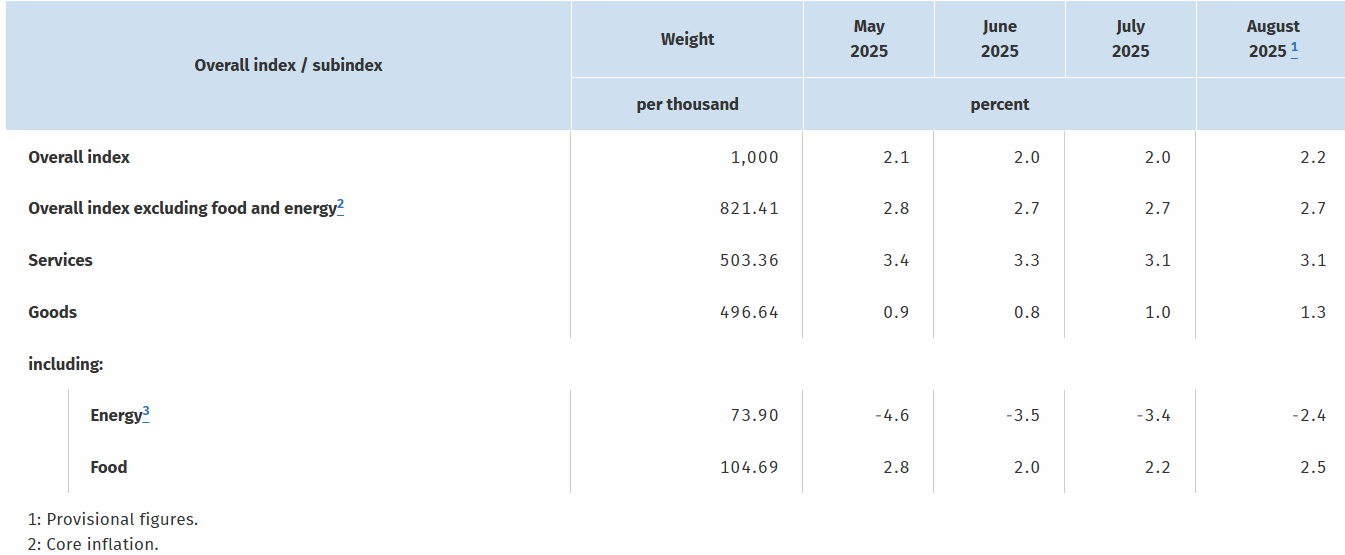
German HICP Review: Headline Back Higher But EZ Price Picture Still Reassuring?
August 29, 2025 12:12 PM UTC
Germany’s disinflation process hit a slightly more-than-expected hurdle in August, as the HICP measure rose 0.3 ppt from July’s 1.8% y/y, that having been a 10-mth low (Figure 1). This occurred largely due to energy base effects with food prices also contributing slightly. The result was that
August 28, 2025
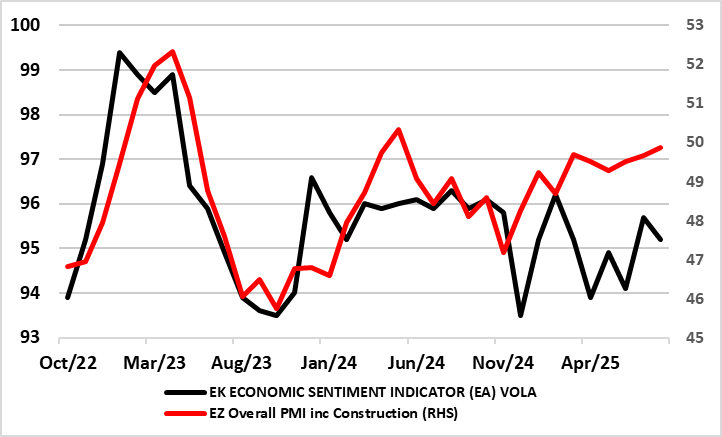
ECB July Account: Policy ‘On Hold’ Leaves Easing Door Open But Less Widely So
August 28, 2025 12:37 PM UTC
The account of the July 23-24 ECB Council meeting saw some discussion about cutting at that juncture but with no immediate pressure to change policy rates what was then exceptional uncertainty added to arguments for keeping interest rates unchanged. In particular, it was seen that maintaining policy
August 26, 2025

EZ HICP and Jobs Review: Headline at Target as Services Inflation at Fresh Cycle-low
August 26, 2025 11:51 AM UTC
HICP, inflation – still at target – is very much a side issue for the ECB at present, albeit with the likes of oil prices and tariff retaliation and a low but far from authoritative jobless rate (Figure 3) possibly accentuating existing and looming Council divides. Regardless, despite adverse
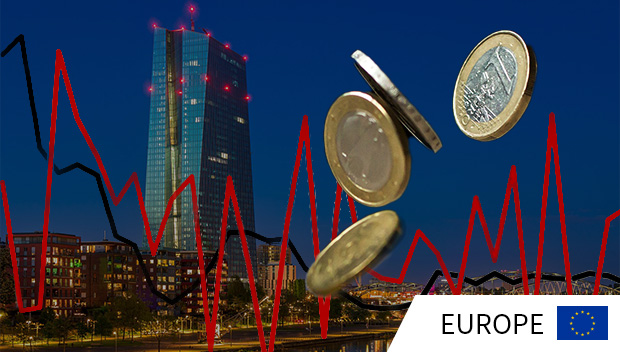
France and Italy: Deficit, ECB QT and Foreign Debt Holders Stories
August 26, 2025 7:35 AM UTC
A large budget deficit in France, looking persistent given the current political impasse, combined with ECB QT means that the market has to absorb a very large 8.5% of GDP of extra bonds. Our central scenario is that persistent French supply causes a further rise in 5yr plus French government yields
August 25, 2025

Jackson Hole: Fed/ECB/BOJ and BOE on Labor Markets
August 25, 2025 9:02 AM UTC
Fed Powell focused on the cyclical softening of employment to back a more dovish undertone. In contrast other central bank heads focused on structural labor market issues. While ECB Lagarde was pleased with the post COVID EZ picture, current economic softness still leaves us forecasting two furt
August 21, 2025
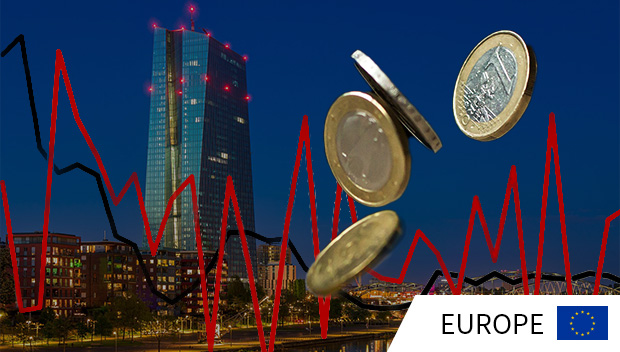
Eurozone: ECB Feels it Has More Reason to ‘Wait and See’?
August 21, 2025 10:02 AM UTC
To suggest that recent EZ real economy indicators, such as today’s August PMI flashes, have been positive would be an exaggeration. But, at the same time, the data (while mixed and showing conflicts - Figure 1) have not been poor enough to alter a probable current ECB Council mindset that the ec
August 20, 2025
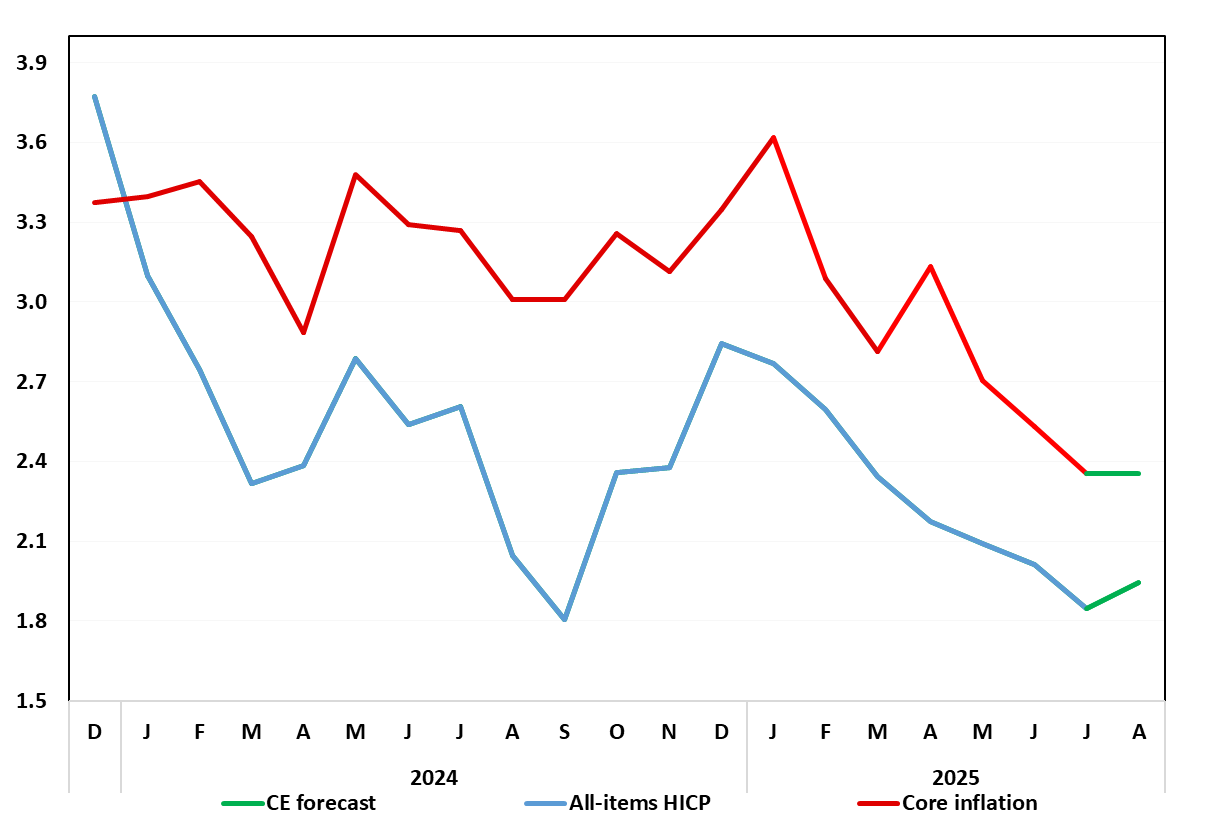
German Data Preview (Aug 29): Base Effects to Pull Headline Back Up - Temporarily?
August 20, 2025 1:39 PM UTC
Germany’s disinflation process continued, with the lower-than-expected July HICP numbers refreshing and reinforcing this pattern, with a 0.2 ppt drop to 1.8% y/y, a 10-mth low (Figure 1). This occurred in spite of adverse energy base effects albeit these likely to feature even more strongly in t
August 18, 2025

U.S. Strategic Fiscal Comparisons
August 18, 2025 9:05 AM UTC
The U.S. short average term to maturity is a structural fiscal weakness if higher rates lift U.S. government interest costs close to the nominal GDP trend. Hence, Trump’s pressure for fiscal dominance of the Fed to deliver lower policy rates and reduce U.S. government interest rate costs. Howeve
August 05, 2025
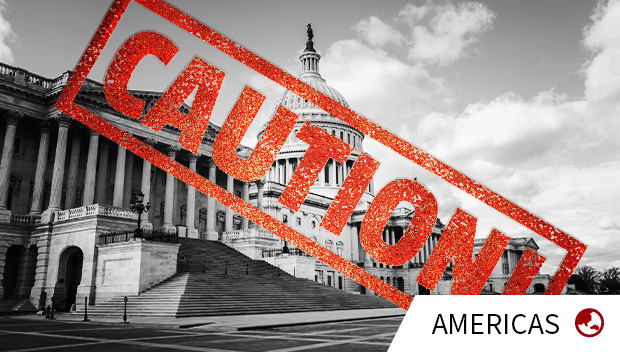
DM Rates: Slowdown Debate Trump’s Independence Question for Now
August 5, 2025 9:50 AM UTC
U.S. Treasury spreads versus other DM government bond markets or 10-2yr U.S. Treasuries are not yet showing a risk premium from the Trump administration attacks on the Fed and economic data. Debate over whether the U.S. is seeing a soft or hard landing are reemerging and this will dominate the outlo
August 04, 2025
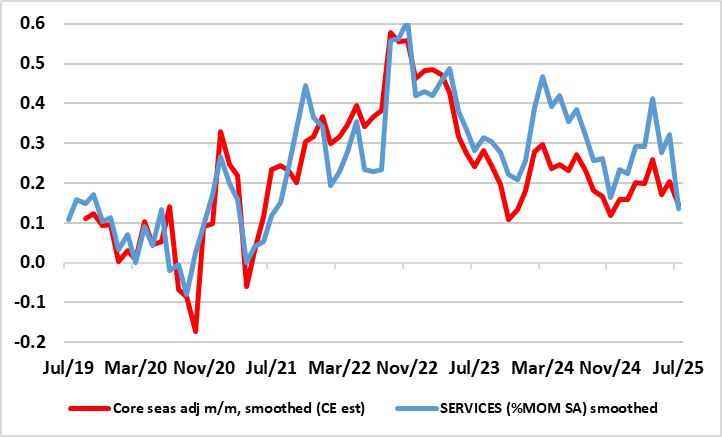
EZ HICP and Jobs Review: Headline at Target as Services Inflation at Fresh Cycle-low
August 4, 2025 8:25 AM UTC
HICP, inflation – still at target – is very much a side issue for the ECB at present, albeit with the likes of oil prices and tariff retaliation and a low but far from authoritative jobless rate (Figure 3) possibly accentuating existing and looming Council divides. Regardless, despite adverse
July 31, 2025
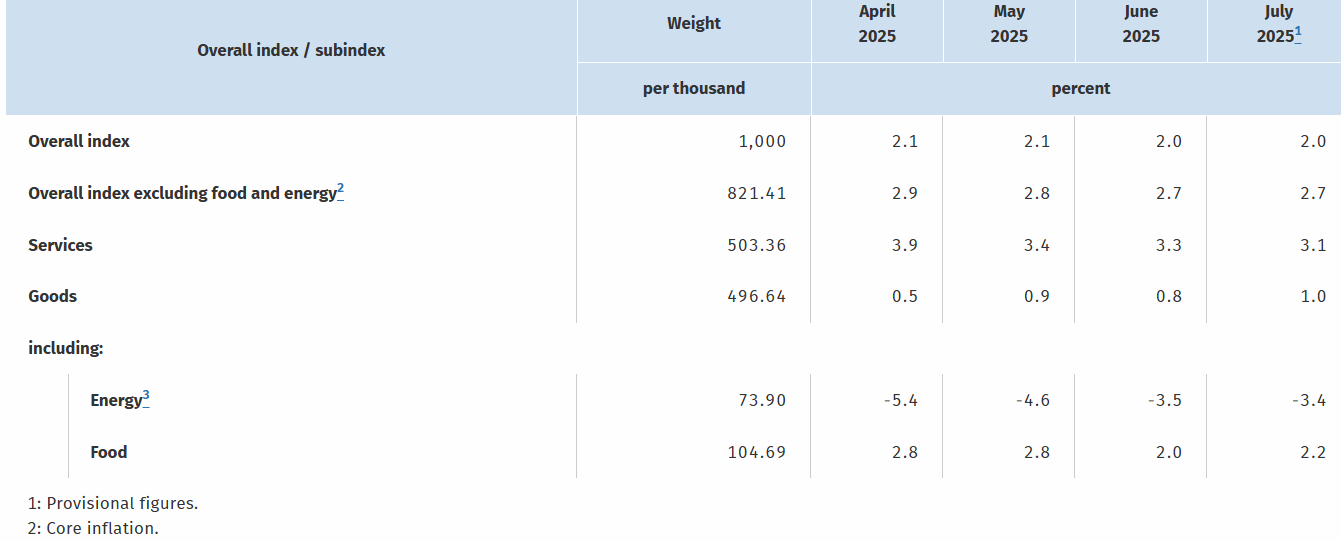
German Data Review: Services Inflation Slows Further?
July 31, 2025 12:39 PM UTC
Germany’s disinflation process continues, with the lower-than-expected July preliminary HICP numbers reinforcing this pattern, with a 0.2 ppt drop to 1.8%, a 10-mth low (Figure 1)! This occurred in spite of adverse energy base effects. Regardless, there was some reversal of June’s surprise and

